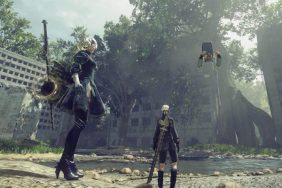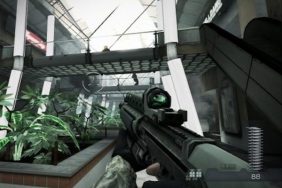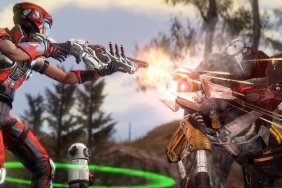Blizzard knows how to make multiplayer games. This is an accepted truth and something of an understatement, considering the years of their lives that people have piled into World of Warcraft and the impact StarCraft has had on the eSports world. However, following the announcement of Overwatch, there were some question marks over whether or not the developer could make an impact in the notoriously over-saturated market, with it being debated if the game’s release on consoles could potentially compete with the monolithic shooters that overshadow the entire genre on the PS4 and Xbox One. Fortunately, not only has Blizzard created a truly masterful FPS game here, but it is a shooter that is so accomplished, it feels almost inevitable that it will stand to have major ramifications on the entire genre.
That this is Blizzard’s first crack at an FPS is a remarkable feat, considering how well-rounded the Overwatch package is. Though it follows in the vein of many modern competitive multiplayer games by opting to overlook a single-player component, its multiplayer offering is robust enough to ensure that this doesn’t particularly detract from the overall experience, with Blizzard having instead pooled its resources into creating an online component that has enough depth to keep you occupied far into the foreseeable future.
Though it takes clear inspiration from Team Fortress 2, Overwatch has a reduced player count of 12 compared to the former’s 24, with two teams of six “Heroes” fighting it out in more streamlined encounters than Valve’s class-based FPS. There are four modes, each belonging to their own set of maps, of which there are 12 in total. The Assault game type sees players capturing or defending control points, Escort tasks attackers with guiding a Payload into their opponents’ base, Control is a best-of-three series of objective-capturing, while the Hybrid game mode combines Assault and Escort in a lengthier battle across larger sized maps. Hopping into a matchmaking session will place you into a constantly rotating series of these game types, with the lack of player-voting between rounds meaning that you’re forced to embrace the entirety of what Overwatch has to offer and not just the one mode you and your friends favor.

Four modes may be something of a paltry offering compared to other multiplayer shooters, but the diversity on display in each map helps Overwatch refrain from veering into tedium. Though the aim of the game in each round is always “stand next to a thing and prevent the enemy team from coming near it,” the variety is in the locations you battle it out in, not in the objectives you’re tasked with safely securing. With each map boasting a distinct theme, from Hollywood movie set through to Egyptian temple, the cartoonish fun exuded by each of them is redolent of early ’00s shooters such as Timesplitters 2, and is a blissful return to a pre-militaristic FPS genre.
The color palettes used for each map are also a result of intelligent design choices by Blizzard, as the subdued tones that coat each stage place the focus upon the Heroes, rather than distract from them. Compare this with Battleborn, Gearbox Software’s recently released and underwhelming class-based shooter, which injects so much color into its maps that it’s often a struggle to distinguish players from their surroundings, and it’s clear why this is so important. Aside from their aesthetic design, the majority of Overwatch‘s maps also boast great variety in terms of their layouts, too. With a number of tight crunch areas, vantage points and shortcuts, it feels like every map has been designed to give each each of the game’s Heroes their own place on the battlefield in which they can prosper.
Also See: Overwatch Character Guide: The Greatest Hero In Every Class
But though Overwatch‘s maps may be impressive, the Heroes are the stars of the show here, with Blizzard having crafted a cast of characters that are as memorable as they are enjoyable to control. Divided into four classes – Offense, Defense, Tank and Support – the 21 Heroes on offer in the game each boast their own distinct weaponry and abilities, granting them unique strengths and weaknesses. Tracer, for instance, is a swift mover with unparalleled evasive abilities and strong firepower, but she also has an exceptionally low health pool that makes her easy to defeat if slowed or surrounded by enemies. On the other hand, Tank character Roadhog is very slow but also has a huge amount of health, along with a devastating primary shotgun attack that can fell an enemy in a few swift shots. Each character has an Ultimate ability, too, with Blizzard taking inspiration from the MOBA genre by providing each class with a potentially game-changing special ability that can prove to be devastating to the enemy team, provided they are pulled off correctly.
Most importantly, though, each Hero is a joy to handle. I can’t remember the last time I had so much fun playing an FPS, with Blizzard having discovered a near-perfect balance between accommodating both the inexperienced player and the skilled veteran. Those who would rank themselves as a below-average FPS player can have a lot of fun by simply building an unmanned turret as Torbjörn and taking down a few enemies, or by controlling the dual shotgun-wielding Reaper and causing colossal damage at close range. Meanwhile, those who consider themselves to be a more adept player will find a lot to love in the likes of Hanzo or Genji, two characters that are more difficult to master but who provide a greater sense of achievement when having done so. Though the better team will always triumph, Overwatch is still a far more welcoming experience to the newcomer than a considerable amount of its peers.

For the most part, Blizzard has done a good job of providing balance throughout its roster of characters, though there are still some who are a little under-powered compared to their teammates. The Support class suffers from this the most, with the fast-moving Lucio dealing out health and speed buffs without so much as having to aim his reticule at his teammates, making him stand head-and-shoulders above his peers. The comparative ineffectiveness of the other Support characters is then increased monumentally when you’re not playing alongside a communicative team, with Overwatch definitely favoring players who are providing each other with vocal prompts in-game. Assuming the role of a character such as Mercy, who can only heal one Hero at a time, is a thankless role when not playing alongside friends, as more often than not the mute teammate you’re trying to heal will fail or outright refuse to defend you. The Support class would have benefited greatly from on-screen prompts which alert teammates to these Heroes’ location on the map, but as it stands there’s little joy in playing as the likes of Mercy when going solo.
Helpful teammates such as Support players are also left out in the cold in Overwatch‘s Play of the Game clips, which show a short highlight of the best moment in the previous match. These are reserved for a player who pulled off a quick series of kills, typically using an Ultimate ability, but as expected you’ll rarely see a Support Hero feature in them. This is somewhat counter-balanced by the end-of-match voting in which players vote for who they believed put on the best performance, but it still feels like Support Heroes are left in the shade, inevitably meaning that fewer people appear to be willing to play as them, regardless of them providing a team with its crucial defensive backbone.
I also have an issue with the pricing of Overwatch‘s microtransactions, which seems too high for Loot Boxes that merely contain cosmetic items. With 2 Loot Boxes retailing for $2 and 50 Loot Boxes for a whopping $40, considering that each box only boasting four items – none of which are guaranteed to be Legendary items or even skins – it’s a little over-priced. With that being said, each Loot Box only contains superficial additions to Overwatch that do not impact upon the game in any meaningful way, so they can be skipped over altogether if you aren’t necessarily interested in equipping all your characters with shiny new outfits. A Loot Box is also awarded to the player each time they level up, which is the only reward they’ll receive for climbing up the game’s progression system, which actually makes a refreshing deviation from other games in the genre which typically seek to hand the best players the best weaponry.
But despite these quibbles, Overwatch remains a triumph. In a genre that appeared to have lost its sense of fun amidst its fetishisation of war, it stands out as wonderful throwback to days when FPS games had color, heart and personality. Blizzard’s first FPS is a resounding success, and a strong contender for the best new IP of this current generation.

Paul Tamburro is the Gaming, Tech and UK Editor for CRAVE. Follow him on Twitter @PaulTamburro.






